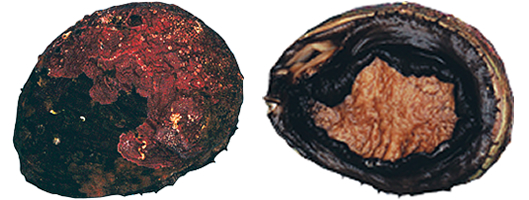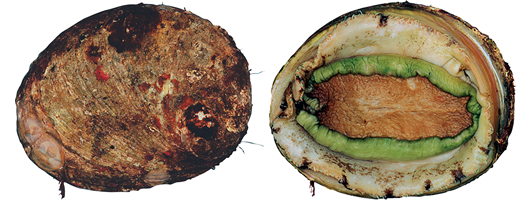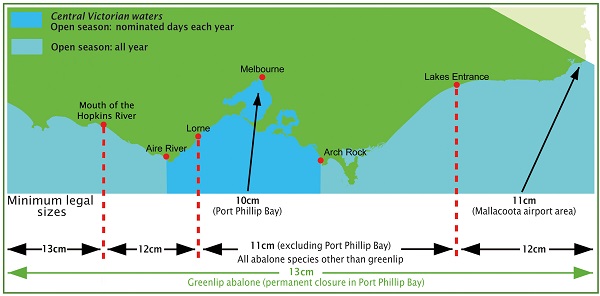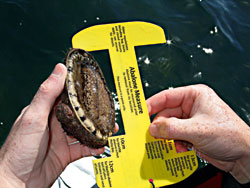Abalone (all species)


| Common name | Abalone (all species) |
|---|---|
| Minimum legal size | The minimum legal size for abalone depends on where they're taken from. Please see the map below of the Central Victorian waters. |
| Bag limit | Port Phillip Bay: 5 blacklip abalone, 0 greenlip abalone All other Victorian waters: 5 abalone of which no more than 2 can be greenlip abalone |
| Possession limit | There is a statewide possession limit for abalone of 10, of which no more than 4 can be greenlip abalone. This is the maximum number of abalone that a person can possess at any one time anywhere in Victoria (including your home) |
| Additional information | You can't collect abalone in waters less than 2m deep (the intertidal zone). Click here for more information on the intertidal zone. You can't collect abalone in Marine National Parks and Sanctuaries. Click here for more information on Marine National Parks and Sanctuaries. You can't collect abalone from the Central Victorian waters except on the nominated days (see below). Abalone are incredibly delicate, and are haemophiliacs. This means that if cut, or even bruised, their blood is unable to clot and they will die. to collect abalone responsibly, please use an abalone tool. Free abalone tools are available by calling 136 186. |
Central Victorian waters
Central Victorian waters are defined as marine waters east of the mouth of Aire River to Arch Rock (near Cape Liptrap) including Port Phillip Bay. The southern boundary is a line running three nautical miles from the coast, which is the seaward limit of state waters.

Recreational abalone open days for Central Victorian waters
There is a permanent closed season on the take of abalone from Central Victorian waters, except for these nominated open days each year:
- Every Saturday and Sunday between 16 November and 30 April the following year inclusive.
- Every declared public holiday in Victoria between 16 November and 30 April the following year.
- 25 December through to the second Sunday in January the following year inclusive.
 Collecting abalone
Collecting abalone
- You must carry a measuring device.
- You must use a blunt instrument when taking abalone.
- You must not use knives, screwdrivers or sharp items that could cut the abalone.
- You must not shuck abalone, or be in possession of shucked abalone, or land shucked abalone, in, under or on Victorian waters, including for use as bait or berley.
- You may only shuck abalone upon the place of consumption.
- You can take abalone only between sunrise and sunset.
Abalone tools are unavailable until further notice.
Staying safe when diving
Diving for abalone is relatively safe, but there is a risk of drowning. To stay safe, you must:
- Dive when sea conditions are good
- Always dive and stay with a friend so there is someone there to help if you get into trouble
- Use a dive flag to let others know where you are
- If conditions are not right, find a better spot or dive on another day
 Measuring your catch
Measuring your catch
Abalone must be measured at the widest part of the shell whether it is whole or damaged, immediately upon removal and returned to the location of take if found to be undersized.
Free measuring devices are available by calling 136 186.
